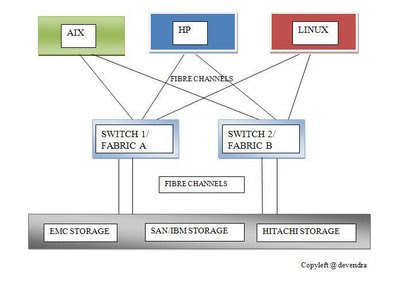Linux kernel treats all devices as file; they can be opened, closed, read and written using the same standard system calls. For every kind of Block and Character Devices, system creates the device files using mknod command and they define the device as major and minor number.
?? what... major and minor number....
Don't worry, I am going to tell about major and minor number... ;-)
To access any device, Operating System must be told what to do. All the routines for the specific device is jointly referred as Device Driver.
All devices controlled by the same device driver have common MAJOR number. MINOR number is used to identify the different devices and their controllers.
In another language, it can be said that: MAJOR number tells what kind of device it is and MINOR number tells about the characterstics/location of the device.
http://www.linux-tutorial.info/modules.php?name=MContent&pageid=94
Friday, January 30, 2009
Sunday, January 4, 2009
Concept on SAN and Switches

In above block diagram of SAN system, we can see mulitple servers : AIX, HP, LINUX and may be SUN, WINDOWS etc connected to storage like EMC, SAN, HITACHI (HDS) through Fibre Channel.
In between Servers and Storage, we can see Switches also called as Fabric. This switch allows the soft zoning in between the servers and storage avoiding direct connection between Servers and Storage.
(SOFT ZONING: It is the logical connection rather than hard connection between the servers and storage )
In switch, we can activate and deactivate the created the zone in between Servers and Storage.
Wait!!! I am missing something..
To create the zoning in between the Server and the Storage, you must have WWPN (World Wide Port Name) of either ends.
FYI there is a GUI software called as EFCM for SAN managementt.
==============================================================
Another thing to notice in above block diagram is that, each server goes to storage via two switches. Why should we use multi path?
Simple answer: For redundancy and multi path allows 2X speed of the data transfer.
Now the next question arises: What controls the multipath?
It's the multi-pathing software installed in the Servers. There are various types of mulitpating softwares. Basically there is MPIO (Multi Path I/O) which is default installed in AIX server.
There is another software: SDD (Subsystem Device Driver) that also controls multipath.
It really depends upon your choice to use either MPIO or SDD.
Multipath can also be considered as the technique employed for Load Balancing.
=============================================================
You know there are many questions in my mind.. ;-)
Now how does the Server recognize the different vendors Storage devices?
It's real easy answer.... It's again the software/filesets.. It's like a device driver which we call Host Attachment Software/Package.
Now the bottom line concept for the SAN system to work, there are three softwares running in the servers: OS, Multipathing software and Host Attachment Software.
================================================================
Are you interested in Switch Trunking? If yes, you can go through it, ok.. Otherwise skip it.. :-)

In above block diagram it says ISL (Inter Switch Link). If the two switches are connected via ISL then this is called as Trunking. And both of the switches behave as a single switch. This increases number of possible switching. This also helps in load balancing.
(FYI: If the ports connected by ISL, the port is called as E Port. Similarly if connected by Fiber, the port is called as F Port. If nothing connected , the port is called G Port)

In SAN system, Domain ID represents Switch. Usually you will find the following notation:
97(1) which implies Switch 1 Port 97
Go and find about QLogic and Emulex...
Hey by the way, I am trying to share only my knowledge. Don't rely 100% in it.. bcoz technology is ever changing. I am trying to update my every postings.
(FYI: If the ports connected by ISL, the port is called as E Port. Similarly if connected by Fiber, the port is called as F Port. If nothing connected , the port is called G Port)

There can be more trunking lines in between two switches for efficient load balancing and efficient switching.
In SAN system, Domain ID represents Switch. Usually you will find the following notation:
97(1) which implies Switch 1 Port 97
Go and find about QLogic and Emulex...
Hey by the way, I am trying to share only my knowledge. Don't rely 100% in it.. bcoz technology is ever changing. I am trying to update my every postings.
Saturday, January 3, 2009
WWPN (World Wide Port Name)
(WorldWide Port Name) The unique serial number burned into Fibre Channel adapters that identifies that network port from all others. The WWPN is the Fibre Channel counterpart of the MAC address in Ethernet adapters.
For the pretty clear concept of FIBRE CHANNEL go to :
http://www.pcmag.com/encyclopedia_term/0,2542,t=Fibre+Channel&i=43129,00.asp
For the pretty clear concept of FIBRE CHANNEL go to :
http://www.pcmag.com/encyclopedia_term/0,2542,t=Fibre+Channel&i=43129,00.asp
IBM server series
P series: POWER series (Performance Enhanced With Enhanced RISC)
To run AIX server
i series: To run ios
Power Systems including AS/400, iSeries, and System i
Z series: Mainframe computers (developed only by IBM)
http://www-03.ibm.com/systems/z/hardware/index.html
DS series: for data storage
X series: x86 architectures INTEL processors;
x86 servers for Windows and Linux
e.g for HMC (Hardware Management Console) server
To run AIX server
- IBM Power Blade servers
- IBM Power 520 Express
- IBM Power 550 Express
- IBM Power 560 Express
- IBM Power 570
- IBM Power 575
- IBM Power 595
i series: To run ios
Power Systems including AS/400, iSeries, and System i
Z series: Mainframe computers (developed only by IBM)
http://www-03.ibm.com/systems/z/hardware/index.html
DS series: for data storage
X series: x86 architectures INTEL processors;
x86 servers for Windows and Linux
e.g for HMC (Hardware Management Console) server
Subscribe to:
Comments (Atom)
